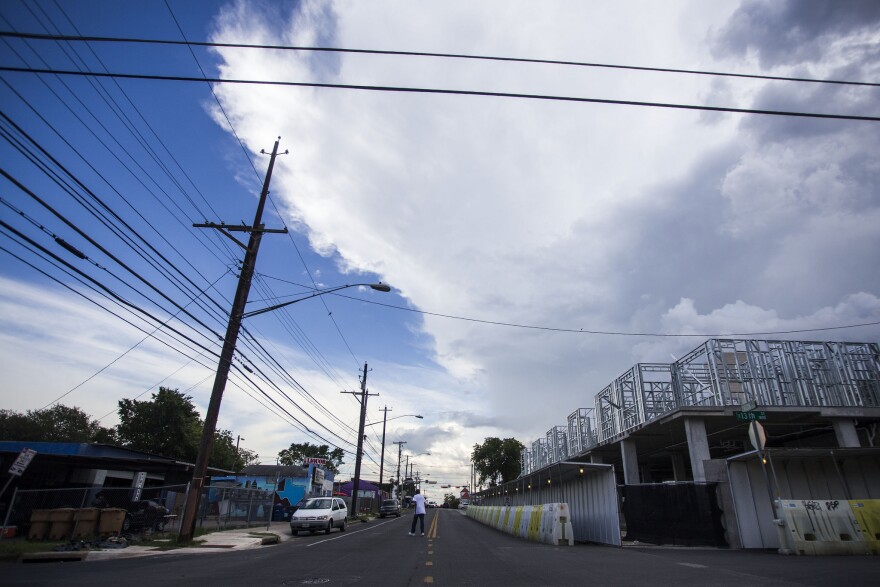For five weeks in 2001, Karen Paup spent her afternoons with other Austin residents talking about the city’s changing Eastside. The group included a pastor, a developer and a now-professor at New York University.
“We shared anecdotes, we looked at data,” said Paup, who works for Texas Housers, a nonprofit focused on low-income housing. “We felt that there was a sense of urgency expressed by the council in setting up the committee and a short timeframe for getting an answer.”

Eventually the committee came up with a dozen recommendations, many of which found their way into current discussions about ways to ease the effects of gentrification: community land trusts, homestead preservation districts and a moratorium on new development.
Now, Austin Mayor Steve Adler is asking that a new task force be formed to study displacement.
“There are obviously a lot of people in the community that are talking about the challenges of displacement and a lot of the community wants us to do something,” he said. Between 2000 and 2010, Central East Austin's black population declined by 14 percent, while its white population increased by 18 percent. “We proposed a task force on displacement that would look at the issue comprehensively and hopefully identify available tools, best practices around the country and things that we could do here.”
Council Member Ora Houston, who represents parts of Central East Austin, initially pushed back.
“I think that the city of Austin does a really good job of doing studies and reports and forming task forces and then those recommendations regarding how to mitigate the thing that we’re studying really never get implemented," she said.
But Houston eventually decided to support the item and will be a co-sponsor when it comes up for a vote at council on Aug. 17. She said while she's cautious of yet another study, she can understand the need given the quick rate of turnover in city leadership.
“It's not that it's not something that's needed. We've got new people in town, we've got new players on the council," she said. "It’s probably OK that we’re doing this, but I don’t want this to be yet another one of those where we get recommendations and then nothing happens. ... In another 17 years, nobody will be here."
A year before the 2001 report Paup helped write came out, city staff came up with ways to address gentrification in East Austin, many of which were echoed in the 2001 report. They also ruled out a few ideas:

In 2003, the city formed another task force. The opening paragraph reads like a narrative familiar to many today:
As Austin has experienced growth during the 1990s – both in its population and in its economy – there have been growing concerns among many citizen groups about the impact of that growth on many of the neighborhoods in the urban core. There is a heightened concern for those neighborhoods in East Austin that include a higher number of moderate-income and low-income households, relative to the rest of the Austin urban core and the Austin M.S.A.
The 2003 group also published a dozen recommendations, many of which echoed those recommendations from the two reports prior – including educating residents about their legal rights regarding homeownership and identify surplus city land where the city could build affordable housing.
The city was unable to identify a system in place to track the progress of recommendations from the 2001 and 2003 reports. Some recommendations have been accomplished, but Paup said she does not think they came directly from the report.
For example, the committee recommended taxing new development in East Austin and reinvesting that money into affordable housing in the area. The city did not put that in place until 2015 – a lost opportunity, Paup said.
“Unfortunately, it took so long for the city to implement it that a lot of the tax value that should have come into that district had just been absorbed into the city budget,” she said.
Just last year, Adler announced a task force on addressing institutional racism. That report, published in April, included a section on housing. The recommendations from that group include the specific and abstract – things like linkage fees, which tax new development, and considering integration a “core value” of the city.
Adler said this new task force could find that previous reports were adequate, and that the recommendations posed in them should be seen through.
“We don’t want to reinvent the wheel,” he said. “There were suggestions made [by] the institutional racism task force that I think need to be moved forward, and this is one way that those ideas can get moved forward and to build a further constituency behind those ideas so they can impact things like the CodeNEXT process we’re working on.”






